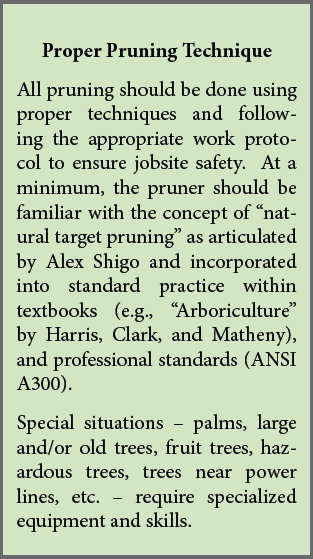[From Dec 2013 issue of the UC IPM Green Bulletin newsletter]
Pruning in Practice
Pruning is perhaps the most common tree maintenance activity that is undertaken on urban and ornamental trees. This is in sharp contrast with forest trees, which are pruned only in exceptional cases and yet grow and develop their mature form quite well, living considerably longer than urban trees. This tells us that trees do not require pruning in order to survive. Nevertheless, in ornamental landscapes, pruning can be beneficial for maximizing the benefits of trees, and in young trees pruning “…provides the greatest benefit of any cultural practice in influencing the future structure, appearance, and maintenance costs.” (Harris, Clark, Matheny, 1999; p 422.). In addition, pruning may be critically important for tree health, whether managing a pathological condition or correcting poor tree form (we will revisit these 
Pruning Effects on Tree Physiology
Removing branches has at least three effects on tree physiology: it diminishes the tree's energy capture ability, draws down the stored energy reserves, and alters the growth pattern of the tree. Potential energy capture by photosynthesis is reduced after pruning, as the total leaf area (the “sugar factory”) is diminished. Additional energy reduction occurs because the starch reserves that had been stored in the removed branch are lost. These two losses can range from negligibly small (e.g., when small twigs are trimmed), to catastrophically large (e.g., when mature trees are “topped,” which severely shortens the large branches). Tree growth is affected in a somewhat paradoxical way, in that the growth of an individual shoot is “invigorated” (i.e., increased) by pruning as the tree's root system is able to direct more water and nutrients into those shoots that remain after pruning. Yet, considered as a whole, a pruned tree will produce less total growth (compared to an un-pruned tree) as its photosynthetic capacity was (at least temporarily) reduced by pruning.
Pruning Effects on Tree Defense Systems
Pruning also affects a tree's ability to resist pathogens and insects, in both direct and indirect ways. In direct terms, the pruning wound presents a potential site of pathogen entry into the tree, an “infection court,” and allows the pathogens to bypass the tree's defense layers. Heartwood, for example, is usually shielded from wood-rot fungi by the bark and sapwood but becomes exposed in branch stubs left after topping cuts. In addition, some insects are attracted to fresh pruning cuts, and these pests can either cause a problem by themselves or by transmitting a pathogen (e.g., some elm bark beetles attracted to pruning cuts are vectors of Dutch elm disease).
Furthermore, large-scale pruning predisposes the tree to insect or pathogen attack by reducing the total energy available to the tree (as described above), thereby limiting the tree's capacity to use this stored energy to defend itself from insects or pathogens by producing defensive compounds (such as pitch) or by limiting the spread of pathogens through the tree (compartmentalization).
![A coast live oak (Quercus agrifolia) in the initial stages of decline from Armillariaroot rot. [Photo by J. Downer] A coast live oak (Quercus agrifolia) in the initial stages of decline from Armillariaroot rot. [Photo by J. Downer]](http://ucanr.edu/blogs/UCIPMurbanpests/blogfiles/23308.png)
Timing
Research results are somewhat conflicting regarding the best time of year to prune. In general, it is not advisable to prune trees at “times of low energy reserves, when a tree is stressed, and when the soil is uncharacteristically dry or flooded ”(Gilman, 2012, p.128). In addition, remember to check for specific insects and diseases that could affect the tree you are about to prune, and ensure that you will not be making the tree “more attractive” to those pests (e.g., prune elms in winter, when the DED vector beetles are inactive.) The removal of large branches in mature trees may predispose trees to insect and disease problems. We can avoid having to remove large branches, by pruning more often to remove small branches before they grow, and thus guide the tree to its optimal form and condition without having to incur the penalty of losing too many leaves and too much stored energy. In three simple steps:
(1) Prune small – prune often!
. . . and limit the total amount of branches removed.
(2) Prune well!
…by making correct cuts; with clean tools, timed to avoid insects and diseases; and disposing of pruned material appropriately.
(3) Respect the natural form!
…by remembering that we cannot “make” a round-headed redwood by pruning or a pole-like coast live oak without severely stressing the tree.
References:
Harris, R. W., Clark J. R., N. P. Matheny, 1999. Aboriculture: Integrated Management of Landscape Trees. Third Edition, Prentice Hall.
Shigo, A. 1989. Tree Pruning, a Worldwide Photo Guide for the Proper Pruning of Trees, 143.
Gilman, E.F. 2012. llustrated Guide to Pruning, Third Edition. Delmar Publishers, Albany, NY., 128.
*(the “good” will appear in the August 2014 issue of the Green Bulletin)
This article was originally published in the December 2013 issue of the UC IPM Green Bulletin. See this and other articles at http://www.ipm.ucdavis.edu/greenbulletin/index.html.
Author - Interim County Director; Bay Area Environmental Horticulture and Urban Forestry Advisor